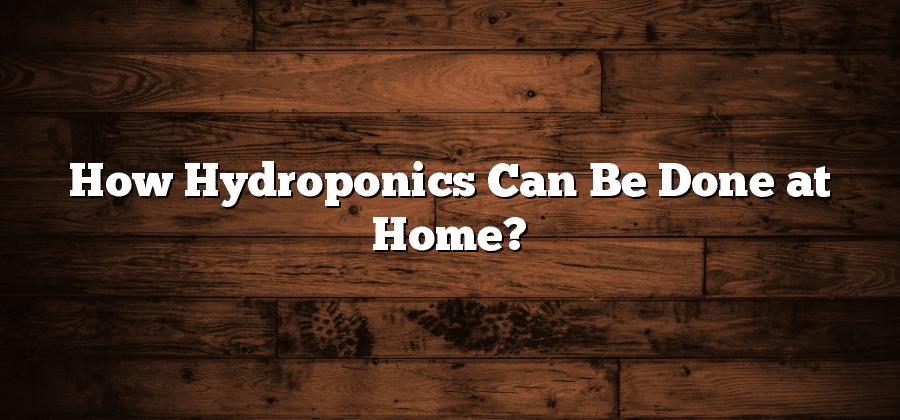Benefits of Hydroponics for Home Gardening
Hydroponics, a soilless method of gardening, offers numerous benefits for home gardeners. One of the key advantages is increased productivity. Since plants in a hydroponic system receive all the essential nutrients directly through their roots, they can grow faster and produce higher yields compared to traditional soil-based gardening. This is particularly beneficial for those with limited space or urban dwellers who may not have access to large gardening areas. Additionally, with hydroponics, there is no need to worry about weeds, pests, or diseases commonly associated with soil-based gardening, making it a more efficient and hassle-free way to grow plants at home.
Furthermore, hydroponics allows for precise control over growing conditions, resulting in healthier and more robust plants. By meticulously adjusting factors such as nutrient levels, pH, and lighting, gardeners can create an ideal environment tailored to the specific needs of their plants. This level of control promotes optimal growth and development, ultimately leading to superior plant quality. Moreover, hydroponics eliminates the variability of soil composition, ensuring that plants receive a consistent supply of nutrients, which enhances their overall health and resilience. With these advantages, hydroponics has become an appealing option for home gardeners looking to cultivate their own fresh and nutritious produce.
Ideal Conditions for Hydroponic Growth
Achieving the ideal conditions for hydroponic growth is crucial in order to maximize the success of your home gardening endeavors. The first aspect to consider is **lighting**. As hydroponic plants rely solely on artificial light sources, it is imperative to provide them with the correct intensity and spectrum. Most commonly, **full-spectrum LED lights** are used, which provide a balanced distribution of light suitable for all stages of plant growth. It is advised to suspend the lights at an appropriate distance above the plants to ensure sufficient coverage and prevent any potential light burn.
Another crucial factor for hydroponic growth is **temperature control**. Maintaining the proper temperature promotes optimal plant growth and prevents the risk of damage. Depending on the plants being cultivated, the ideal temperature range generally falls between **70°F to 80°F (21°C to 27°C)**. It is important to monitor and adjust the temperature accordingly, considering factors such as the room’s ambient temperature, light intensity, and water temperature, as they all play a role in influencing the overall temperature of the hydroponic system. Additionally, ensuring proper air circulation within the growing area can help maintain a consistent temperature and prevent the buildup of excess humidity.
Successful hydroponic growth is highly dependent on creating and maintaining the ideal conditions for your plants. Attention to lighting and temperature control are essential aspects to consider in order to provide the best environment for your hydroponic garden. However, other factors, such as nutrient balance, pH levels, and humidity, also need to be carefully managed to ensure optimal results. By understanding and addressing these key aspects, you can create the perfect conditions for your plants to thrive and achieve a successful hydroponic home garden.
Choosing the Right Hydroponic System
There is a wide range of hydroponic systems available in the market, each with its own advantages and limitations. When it comes to choosing the right hydroponic system for your home gardening needs, it is essential to consider several factors. Firstly, evaluate the space available for your hydroponic setup. If you have limited space, a vertical or compact system such as a nutrient film technique (NFT) or a vertical tower system might be the most appropriate choice. On the other hand, if space is not an issue, larger systems like a deep water culture (DWC) or a drip irrigation system could be more suitable.
Another crucial consideration when selecting a hydroponic system is the level of involvement and expertise you are willing to commit. Some systems, such as a Kratky or a wick system, require minimal maintenance and are ideal for beginners or those with limited time. Conversely, more complex systems like an ebb and flow or a aeroponic system demand a higher level of skill and attention. It is important to thoroughly research and understand the requirements, benefits, and drawbacks of each system before making a decision.
Selecting the Best Plants for Hydroponics
When choosing plants for a hydroponic system, it is important to select varieties that are well-suited to this unique method of gardening. Some plants thrive in hydroponic environments, while others may struggle to adapt. It is crucial to consider factors such as the plant’s root structure, nutritional needs, and overall growth habits before making a selection.
One important factor to consider is the plant’s root structure. In hydroponics, plants are grown in nutrient-rich water without soil. This means that plants with complex root systems, such as carrots or potatoes, may not be suitable for hydroponic cultivation. Instead, it is best to choose plants that have a more compact and efficient root system, such as lettuce, herbs, or leafy greens.
Additionally, the nutritional needs of the selected plants should be taken into account. Hydroponic systems provide all the necessary nutrients directly to the plants through the water. Some plants require specific ratios and concentrations of nutrients, while others are more adaptable. It is important to research the nutritional requirements of each plant and ensure that the hydroponic system can provide those specific nutrients in the correct proportions.
Lastly, understanding the growth habits of the chosen plants is essential to ensure their success in a hydroponic system. Some plants, like tomatoes or cucumbers, tend to grow tall and vining, requiring sturdy support structures. Others, like strawberries or peppers, have a more compact growth habit and may thrive in smaller spaces. Considering these growth habits will allow for proper planning and space utilization within the hydroponic system.
In conclusion, selecting the best plants for hydroponics involves careful consideration of their root structure, nutritional needs, and growth habits. By choosing plants that are well-suited to hydroponic gardening, enthusiasts can ensure optimal growth and yield in their home hydroponic systems.






